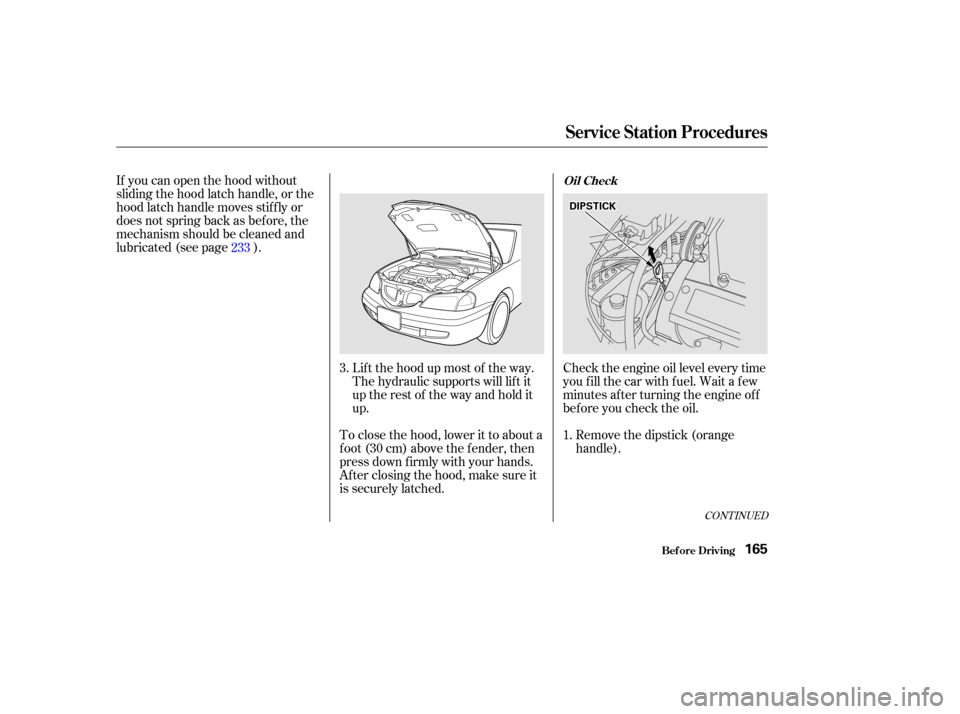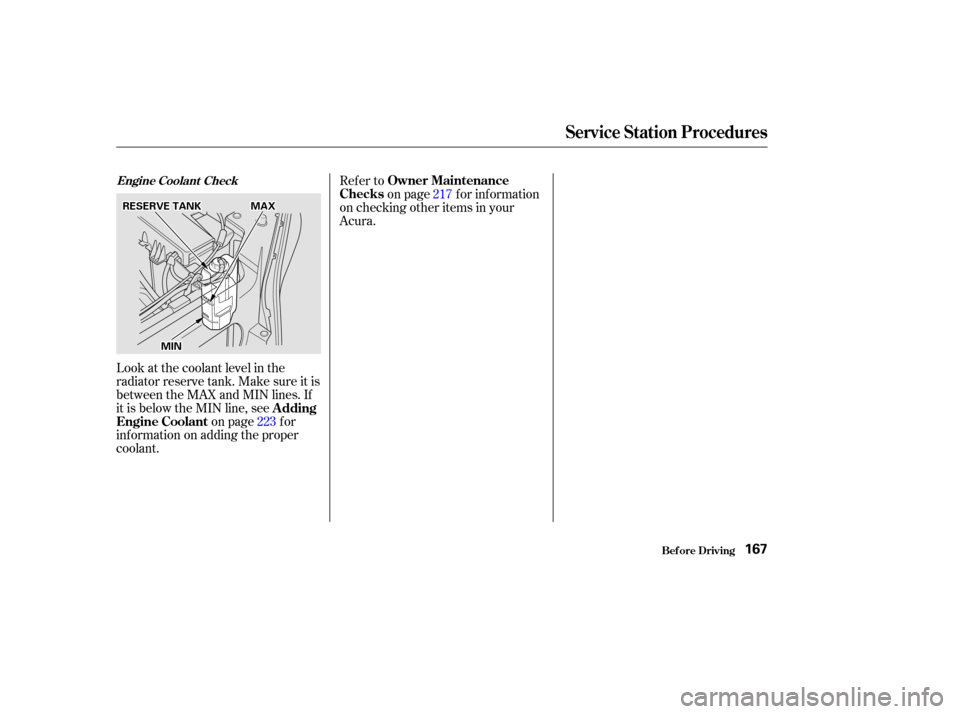check engine Acura CL 2002 Owner's Manual
[x] Cancel search | Manufacturer: ACURA, Model Year: 2002, Model line: CL, Model: Acura CL 2002Pages: 335
Page 49 of 335

If the light comes on at any other
time, or does not come on at all, you
should have the system checked by
your dealer. For example:If the SRS indicator light does not
come on after you turn the ignition
ON (II).
If the light stays on after the
engine starts.
If the light comes on or f lashes on
andoff whileyoudrive.
Thepurposeof theSRS
indicator light is to alert
you to a potential problem with your
f ront airbags. This light will also
alert you to a potential problem with
your automatic seat belt tensioners
(page );oryoursideairbagsor
passenger’s side airbag automatic
cutof f system (page ).
When you turn the ignition ON (II),
this indicator will light brief ly then
go out. This tells you that the system
is working properly. If you see any of these indications,
your f ront or side airbags may not
deploy, your passenger’s side airbag
automatic cutoff system may not
work properly, or your seat belt
tensioners may not work when you
need them. See your Acura dealer as
soon as possible.
41
47
How the SRS Indicator L ight
Works
Additional Inf ormation About Your Airbags
Driver and Passenger Saf ety46
Ignoring the SRS indicator light
can result in serious injury or
death if the airbags, cutoff
system, or tensioners do not
work properly.
Have your vehicle checked by a
dealer as soon as possible if
the SRS light alerts you to a
potential problem.
Page 58 of 335

This light has two f unctions:This indicator comes on when you
turn the ignition switch ON (II). It
is a reminder to check the parking
brake. Driving with the parking
brake not f ully released can
damage the brakes and tires.
If the indicator remains lit after
you have f ully released the
parking brake while the engine is
running, or if it comes on while
driving, it can indicate a problem
in the brake system. For complete
inf ormation, see page .
The engine can be severely damaged
if this light f lashes or stays on when
the engine is running. For complete
inf ormation, see page .
If this light comes on when the
engine is running, the battery is not
being charged. For complete
inf ormation, see page .
See page .
The instrument panel has many
indicators to give you important
inf ormation about your car.
This indicator lights when you turn
the ignition switch ON (II). It is a
reminder to you and your passengers
to protect yourselves by f astening
the seat belts. A beeper also sounds
if you have not fastened your seat
belt.
If you do not f asten your seat belt,
the beeper will stop af ter a f ew
seconds but the light stays on until
you do. Both the light and the beeper
stay of f if you f asten your seat belt
bef ore turning on the ignition.
1.
2.
292
288
289
290
Indicator L ights
Inst rument s and Cont rols
Parking Brake and Brake System
Indicator
L ow Oil Pressure
Indicator
Charging System
Indicator
Malf unction Indicator
Lamp
Seat Belt Reminder L ight
55
U.S. Canada
Page 59 of 335

This indicator lights when you turn
the ignition switch ON (II). If it
comes on at any other time, it
indicates that the passenger’s side
airbag has automatically shut off.
For complete inf ormation, see page.
This indicator lights when you turn
the ignition switch ON (II). If it
comes on at any other time, it
indicates a potential problem with
your f ront airbags. This light will
also alert you to a potential problem
with your side airbags, passenger’s
side airbag automatic cutoff system
or automatic seat belt tensioners.
For complete inf ormation, see page
.
This indicator comes on f or a f ew
seconds when you turn the ignition
switch ON (II). It will then go of f if
you have inserted a properly-coded
ignition key. If it is not a properly-
coded key, the indicator will blink
and the engine will not start (see
page ).
This indicator also blinks several
times when you turn the ignition
switch f rom ON (II) to ACCESSORY
(I) or LOCK (0).
This lights when you set the cruise
control. See page f or inf ormation
on operating the cruise control.
This light normally comes on f or a
f ew seconds when you turn the
ignition switch ON (II), and when
the ignition switch is turned to
START (III). If this light comes on at
any other time, there is a problem in
theABS.If thishappens,takethe
cartoyourdealertohaveitchecked.
With the light on, your car still has
normal braking ability but no anti-
lock. For complete inf ormation, see
page .
4746
151
74
189
Indicator L ights
Inst rument s and Cont rols
Side A irbag Cutof f
Indicator Supplemental Restraint
System Indicator
Immobilizer System
Indicator
Cruise Control Indicator
Anti-lock Brake System (ABS)
Indicator
56
U.S. Canada
Page 60 of 335

If this light comes on and stays on at
any other time, or it does not come
on when you turn the ignition switch
ON (II), there is a problem with the
VSA system. Take the car to your
dealer to have it checked. Without
VSA, your car still has normal
driving ability, but will not have VSA
traction and stability enhancement.
See page f or more inf ormation
on the VSA system. This indicator normally comes on f or
a f ew seconds when you turn the
ignition switch ON (II).This indicator normally comes on f or
a f ew seconds when you turn the
ignition switch ON (II). See pagef or more inf ormation on the
VSA system. It comes on along with the VSA
system indicator if there is a
problem with the VSA system. It flashes when VSA is active (see
page ). Itcomesonasareminderthatyou
have turned of f the Vehicle
Stability Assist (VSA) system.
This indicator has three f unctions: This indicator has three f unctions:
Itcomesonasareminderthatyou
have turned off the Traction
Control System.
It f lashes when the TCS is
regulating wheelspin.
If itcomesonandstaysonwhen
the Traction Control System is on,
it indicates that there is a problem
in the TCS.
This light also comes on when you
turn the ignition ON (II) and goes off
af ter the engine starts. See page f or more inf ormation on the
TCS.
1.
2.
3.
1.
2.
3.
193 193
193 190
On Premium model
On Type-S
On Type-S
Vehicle Stability Assist
(VSA ) System Indicator VSA A ctivation Indicator
T raction Control System
(T CS) Indicator
Indicator L ights
Inst rument s and Cont rols57
Page 65 of 335

This indicator displays the outside
temperature in Fahrenheit in U.S.
models, and in Centigrade in
Canadian models.
In certain weather conditions,
temperature readings near f reezing
(32°F, 0°C) could mean that ice is
f orming on the road surf ace. The temperature sensor is located in
the f ront bumper. Theref ore, the
temperature reading can be af f ected
by heat ref lection f rom the road sur-
f ace, engine heat, and the exhaust
f rom the surrounding traf f ic. This
can cause the temperature reading
not to be correct when your speed is
under 19 mph (30 km/h).This shows how much f uel you have.
It is most accurate when the car is on
level ground. It may show slightly
more or less than the actual amount
whenyouaredrivingoncurvyor
hilly roads.
This shows the temperature of the
engine’s coolant. During normal
operation, the pointer should rise
from the bottom mark to about the
middle of the gauge. In severe
driving conditions, such as very hot
weather or a long period of uphill
driving, the pointer may rise to near
the upper red mark. If it reaches the
red (Hot) mark, pull saf ely to the
side of the road. Turn to page f or
instructions and precautions on
checking the engine’s cooling
system. The needle returns to the bottom
after you turn off the ignition. The
gauge shows the f uel level reading
immediately af ter you turn the
ignition switch back ON (II).
286
Gauges
Inst rument s and Cont rols
Fuel Gauge
Temperature Gauge
Outside Temperature Indicator
62
Please ref uel early, as driving to the
last drop of f uel can result in damage
to the engine and/or three way catalytic
converter.
Page 164 of 335

Bef ore you begin driving your Acura,
youshouldknowwhatgasolineto
use, and how to check the levels of
important f luids. You also need to
know how to properly store luggage
or packages. The inf ormation in this
section will help you. If you plan to
add any accessories to your car,
please read the inf ormation in this
section f irst..............................
Break-in Period .162
.........................................
Gasoline .162
.........
Service Station Procedures . 163
................
Filling the Fuel Tank . 163
....................
Opening the Hood .164
...............................
Oil Check .165
.........
Engine Coolant Check . 167
...............................
Fuel Economy .168
............................
Car Condition .168
...........................
Driving Habits .168
...
Accessories and Modif ications . 169
.............................
Carrying Cargo .171
Bef ore Driving
Bef ore Driving161
Page 168 of 335

CONT INUED
If you can open the hood without
sliding the hood latch handle, or the
hood latch handle moves stif f ly or
does not spring back as bef ore, the
mechanism should be cleaned and
lubricated (see page ).Check the engine oil level every time
you f ill the car with f uel. Wait a f ew
minutes af ter turning the engine of f
bef ore you check the oil.Remove the dipstick (orange
handle).
Lif t the hood up most of the way.
The hydraulic supports will lif t it
uptherestof thewayandholdit
up.
To close the hood, lower it to about a
f oot (30 cm) above the f ender, then
press down f irmly with your hands.
After closing the hood, make sure it
is securely latched. 1.
3.
233
Service Station Procedures
Bef ore Driving
Oil Check
165
D D
I
IPP S
ST TI
ICCK K
Page 170 of 335

Look at the coolant level in the
radiator reserve tank. Make sure it is
between the MAX and MIN lines. If
it is below the MIN line, seeon page f or
inf ormation on adding the proper
coolant. Refer to
on page f or inf ormation
on checking other items in your
Acura.
223 217
Service Station Procedures
Bef ore Driving
Engine Coolant Check
A dding
Engine Coolant Owner Maintenance
Checks
167
R RE ES
SE ER
RV V E
E T
TA
A N
NK K
M
M I
INN M
M
A
AX
X
Page 171 of 335

A cold engine uses more f uel than a
warm engine. It is not necessary to
‘‘warm-up’’ a cold engine by letting it
idle f or a long time. You can drive
away in about a minute, no matter
how cold it is outside. The engine
will warm up f aster, and you get
better f uel economy. To cut down on
the number of ‘‘cold starts,’’ try to
combine several short trips into one.
You can improve f uel economy by
driving moderately. Rapid acceler-
ation, abrupt cornering, and hard
braking use more f uel.
Always drive in the highest gear that
allows the engine to run and acceler-
ate smoothly.
An important part of that mainte-
nance is the (see page ). For
example, an underinf lated tire
causes more ‘‘rolling resistance,’’
which uses f uel. It also wears out
f aster, so check the tire pressure at
least monthly. The air conditioning puts an extra
load on the engine which makes it
usemorefuel.Turnoff theA/Cor
set the climate control to a higher
temperature to cut down on air
conditioning use. Use the f low-
through ventilation when the outside
air temperature is moderate.
The condition of your car and your
driving habits are the two most
important things that affect the fuel
mileage you get.
Always maintain your car according
to the maintenance schedule. This
will keep it in top operating condition.
In winter, the build-up of snow on
your car’s underside adds weight and
rolling resistance. Frequent cleaning
helps your f uel mileage and reduces
thechanceof corrosion.
Depending on traf f ic conditions, try
to maintain a constant speed. Every
time you slow down and speed up,
your car uses extra f uel. Use the
cruise control, when appropriate, to
increase f uel economy.
217 Driving Habits
Owner Maintenance
Checks Car Condition
Fuel Economy
Bef ore Driving168
Page 179 of 335

Make sure all windows, mirrors,
and outside lights are clean and
unobstructed. Remove f rost, snow,
or ice.
Check that the hood and trunk are
f ully closed.Check the adjustment of the
inside and outside mirrors (see
page ).
Check the adjustment of the
steering wheel (see page ).
Make sure the doors are securely
closed and locked.
Fasten your seat belt. Check that
your passengers have f astened
their seat belts (see page ).Turn the ignition switch ON (II).
Check the indicator lights in the
instrument panel.
Start the engine (see page ).
Check the gauges and indicator
lights in the instrument panel (see
page ).
Visually check the tires. If a tire
looks low, use a gauge to check its
pressure.
Check that any items you may be
carrying with you inside are stored
properly or f astened down
securely.
Youshoulddothefollowingchecks
and adjustments every day bef ore
you drive your car.
Check the adjustment of the seat
(see page ).
1.
2.
3.
4. 5.
6.
7.
8.
9.
53
15 10.
11.
12.
86
93 71 177
Preparing to Drive
Driving176